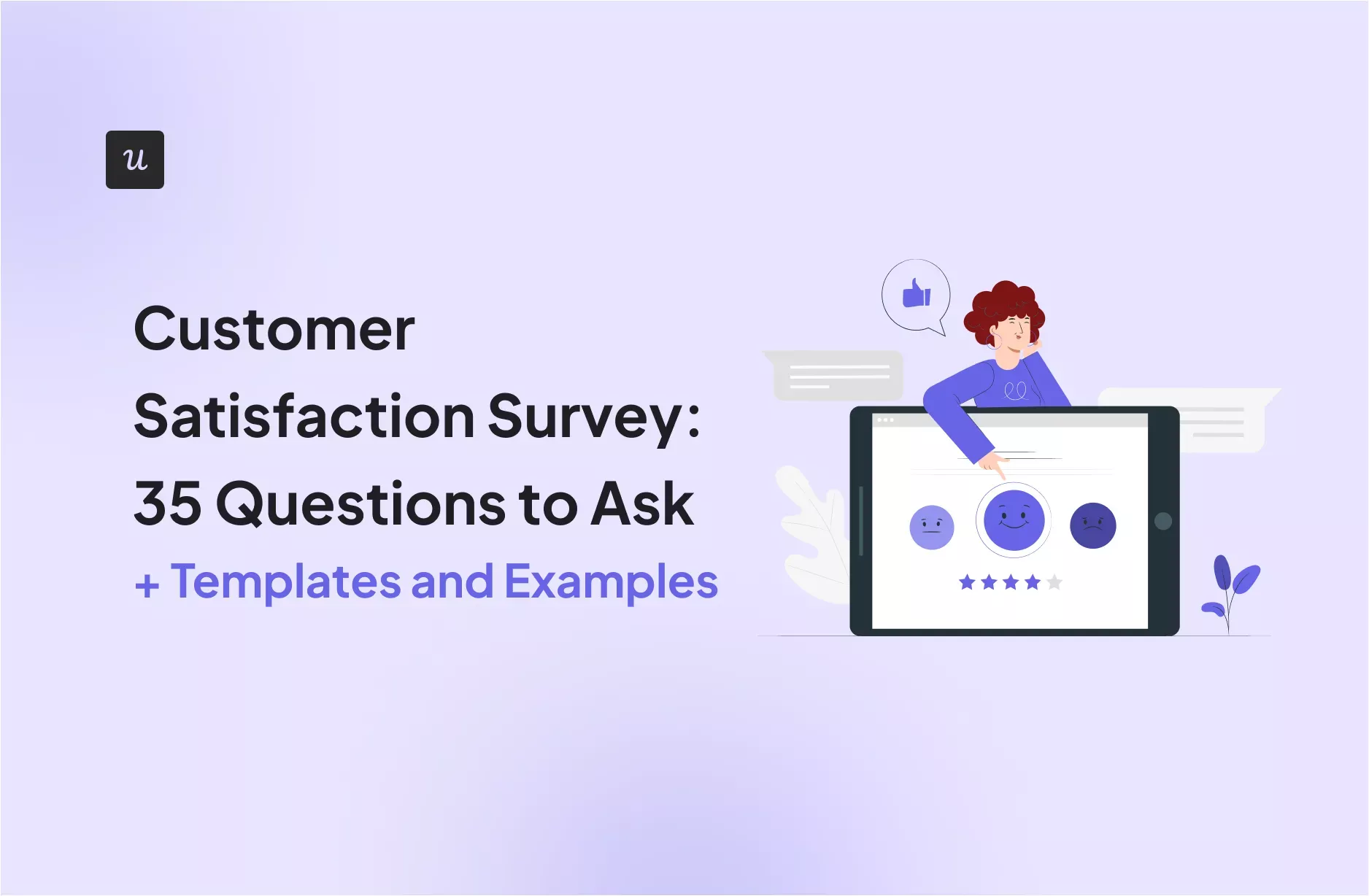
Customer Satisfaction Survey: 35 Questions to Ask + Templates and Examples
A customer satisfaction survey can help you avoid getting fired. Not by your manager, though. But, by your customers.
That’s because they allow you to understand how well your product meets their needs and how you can improve it to improve user experience so that they don’t switch to a competing solution.
In this article, you will learn how to conduct customer satisfaction surveys to gather user feedback effectively.
You will discover:
- Different types of customer satisfaction surveys.
- Customer satisfaction survey templates and questions to ask (35 of them).
- How to create satisfaction surveys in Userpilot.
- Satisfaction survey best practices.
- Five examples of excellent satisfaction surveys from leading companies for inspiration.
- Answers to some frequently asked questions.
Try Userpilot Now
See Why 1,000+ Teams Choose Userpilot

What is a customer satisfaction survey?
A customer satisfaction survey is a questionnaire designed to gauge how well your product satisfies customer needs and how happy they are with the overall customer experience.
Why should you care?
Satisfied customers stay with your company, upgrade to higher plans, and recommend your product to their mates – all of which are essential for sustainable growth.
3 types of customer satisfaction surveys (+templates)
Growth teams use 3 basic types of customer satisfaction surveys.
1. Customer satisfaction score (CSAT)
The customer satisfaction score (CSAT) survey asks the customer a direct question: How satisfied are you with the product/feature?
It asks customers to rate their satisfaction on a scale, typically 1-5, where 1 indicates very unsatisfied and 5—very satisfied.
To calculate the score, divide the number of positive responses by the total number of respondents and multiply by 100. So if 150 out of 200 users respond they’re satisfied or very satisfied, your CSAT score is 75.
The main advantage of this type of survey is that it’s easy to design, and you can use it to measure satisfaction at various touchpoints in the customer journey.
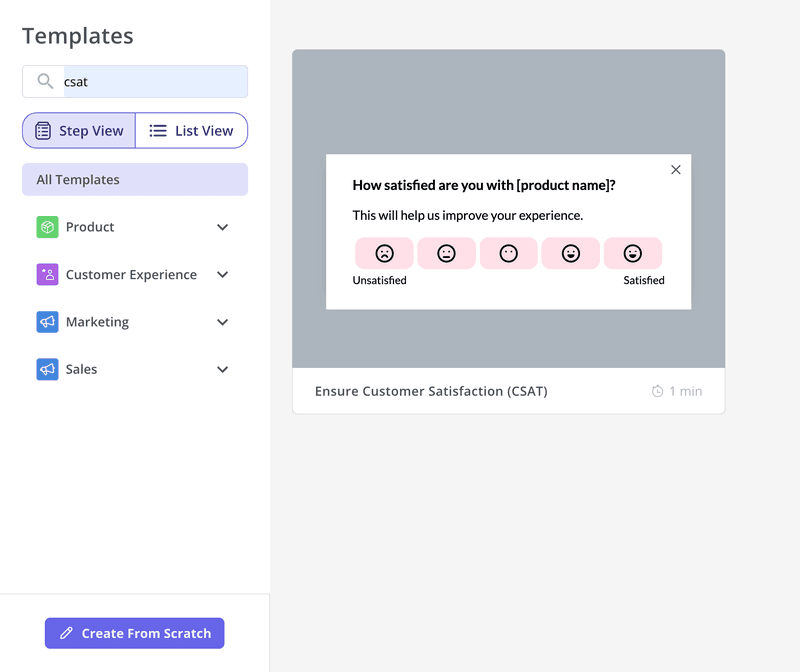
2. Net Promoter Score (NPS)
Net Promoter Score (NPS) surveys ask customers how likely they are to recommend their product to friends or colleagues on a scale of 1-10.
Based on the responses, you classify users into detractors (0-6), passives (7-8), and promoters (9-10).
To calculate the score, deduct the percentage of detractors from the percentage of promoters. So, if you surveyed 200 users, 120 of them were promoters and 40 detractors, the score would be 40 (60%-20%).
Some say NPS is a better measure of customer satisfaction than CSAT because users are less likely to recommend a product they’re not satisfied with. Because their reputation is at stake.
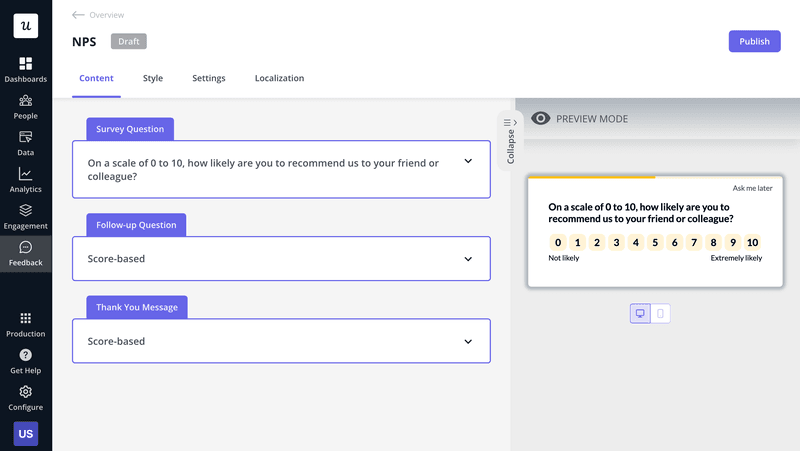
3. Customer effort score (CES)
Customer effort score (CES) surveys focus on how easy it is to use the product or perform an action.
Just like the other satisfaction survey types, it asks users to rate their experience on a scale, usually 1-5, sometimes 1-3, where 1 is ‘very hard.’
CES surveys measure customer satisfaction indirectly: users aren’t likely to be satisfied with products that are difficult to use. And the harder the action to complete, the less likely they are to complete it. This means low CES often translates into high customer churn rates.
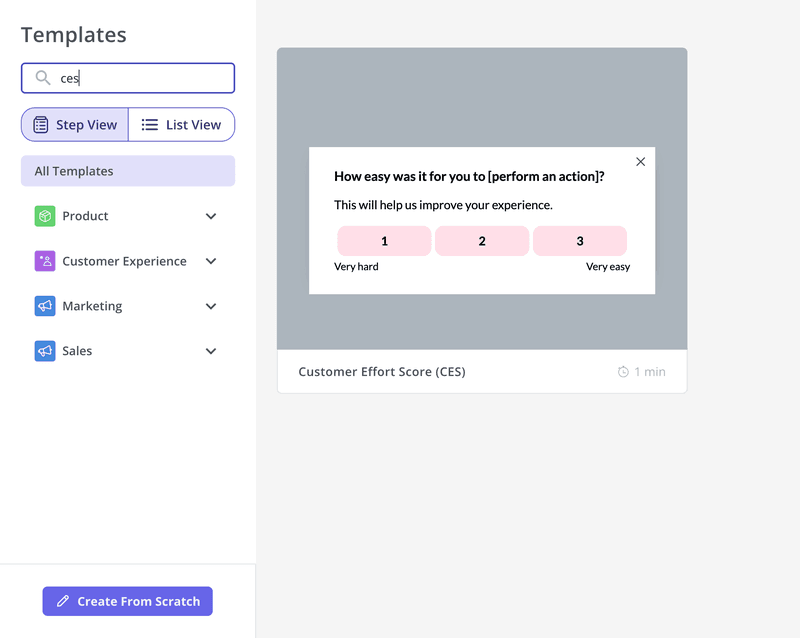
35 customer satisfaction survey questions to ask for better insights
There are more customer satisfaction questions you can ask than the CSAT, NPS, or CES ones. Here are 35 of them, conveniently divided into 4 categories.
Product satisfaction questions
- How satisfied are you with the quality of the product?
- How well does our product meet your expectations?
- Does our product help you achieve your goals?
- How often do you use our product?
- How would you rate the value for money of our product?
- On a scale of 1 to 5, how satisfied are you with the ease of use of our product?
- How likely are you to continue using our product?
- Are there any features you would like us to add to our product?
- How does our product compare to others you’ve used?
- On a scale of 1 to 5, how would you rate your overall satisfaction with our product?
Customer loyalty questions
- How likely are you to recommend our product to others?
- Would you purchase our product again?
- How likely are you to try other products from our company?
- How long have you been a customer of our company?
- What was the primary reason for choosing our product over competitors?
- Have you ever recommended our product to someone else?
- How likely are you to stay with our company over the next 12 months?
- If you could, would you choose to switch to a competitor’s product?
- How would you describe your loyalty to our brand?
- What factors would increase your loyalty to our company?
Customer experience questions
- How satisfied are you with your overall experience with our company?
- How easy was it to find the information you were looking for on our website?
- Was our product/service delivered on time?
- How would you rate your experience with the checkout process?
- How seamless was your experience on our website?
- Did you have any problems during your purchase?
- How would you rate the quality of communication from our team?
- Did our product meet your expectations in terms of quality?
- How easy was it to interact with our brand?
- How satisfied are you with the personalization of your experience?
Customer support satisfaction questions
- How satisfied are you with the support you received?
- Was your issue resolved in a timely manner?
- How would you rate the professionalism of our customer service team?
- Was the support provided clear and easy to understand?
- How helpful were the knowledge base resources?
How to easily create a customer satisfaction survey in Userpilot?
Customer satisfaction surveys can help you improve customer loyalty and retention. For example, Unolo, one of our customers, managed to reduce their user churn rate by 1% by acting on the insights from the NPS surveys. That’s huge!
And the best part?
Creating the surveys took them minutes, thanks to Userpilot’s intuitive design and template library.
Here’s how to do it:
Step 1: In the menu, click on Feedback and choose Surveys. On the dashboard, click on the Create Survey button in the top-right corner.
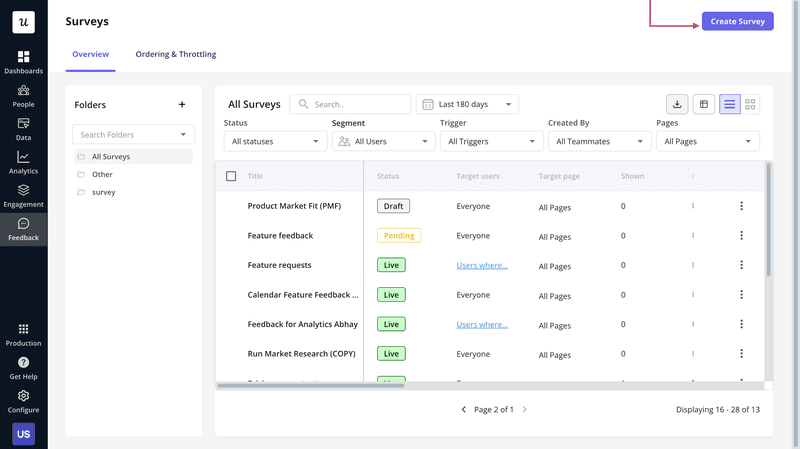
Step 2: Pick a template from the library. If you’re after a specific survey, like the CSAT or CES survey, use the search bar for efficiency.
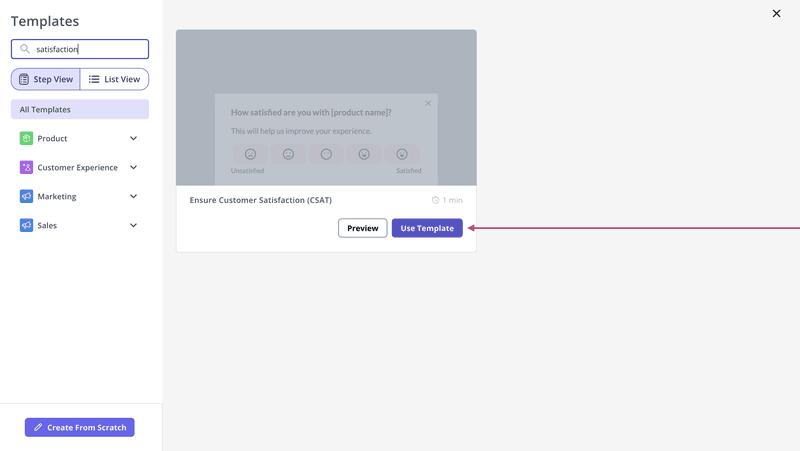
Step 3: Alternatively, create your own customer satisfaction survey from scratch by clicking on the button at the bottom.
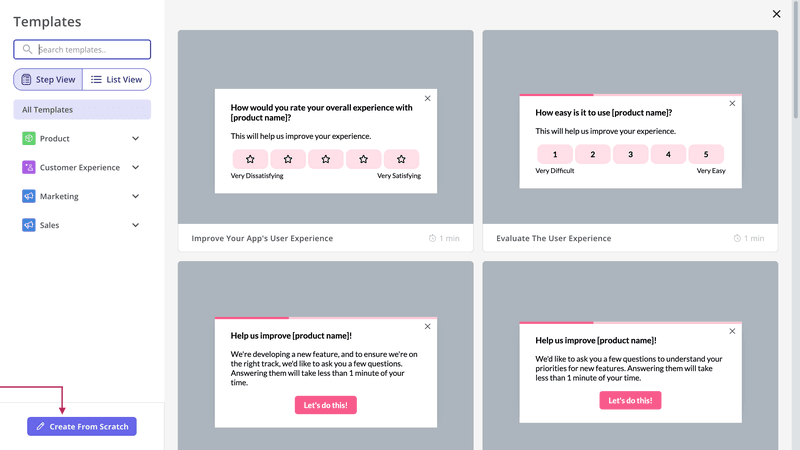
Step 4: Name your survey, choose the folder where you want to save it, and select one of the two views:
- Step view: questions appear on separate pages.
- List view: all questions appear on the same page.
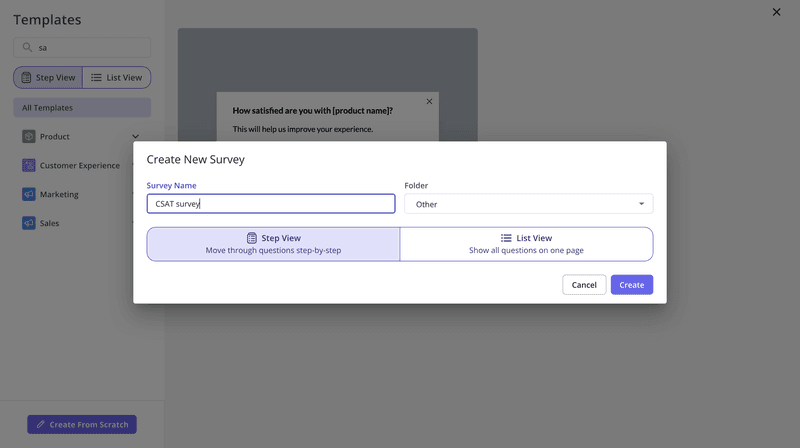
Step 5: Tailor the survey to meet your needs: add the questions, customize the style, choose when to trigger the survey (specific time/day or event-based), and determine which customer segments to target.
You can also translate your survey for users who don’t speak your language.
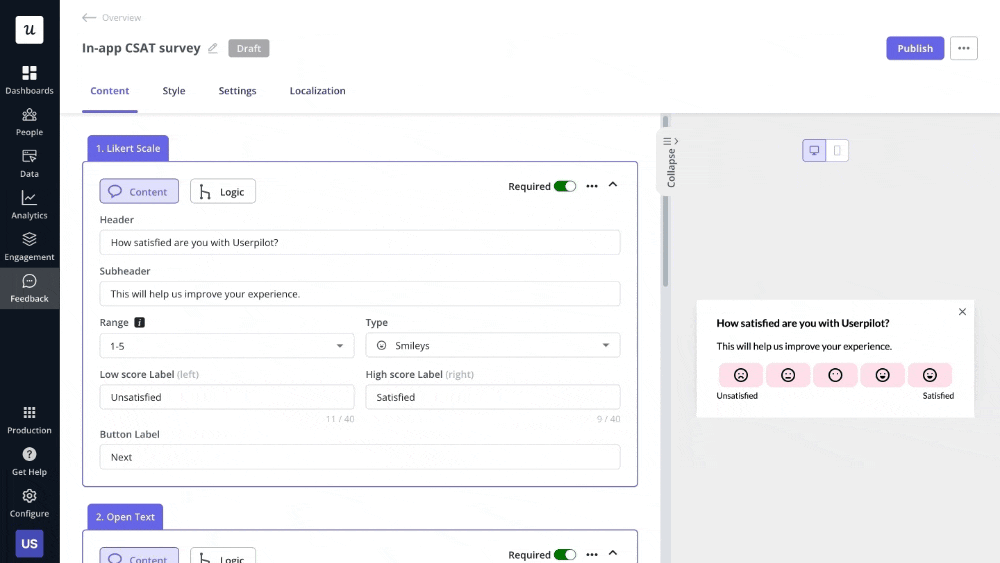
Looks like a breeze, doesn’t it?
If you’d like to learn more about Userpilot surveys, book the demo!
Best practices for creating customer satisfaction surveys
Now that you know how to create in-app surveys in Userpilot, let’s look at a few best practices. So that you can get the most out of them.
Include both closed- and open-ended questions
The CSAT, NPS, or CES questions above are all closed-ended questions, which means users can only choose one of the answers. These questions are quick to answer and provide quantitative data that is easy to analyze. They are great for tracking shifts in customer satisfaction over time.
But here’s the thing:
They don’t tell you why customers feel about the interactions with your product in a particular way.
To gain more granular insights, you need open-ended questions, so that users can freely write what’s in their hearts and on their chests.
Don’t make them compulsory, though, or your response rates will take a hit.
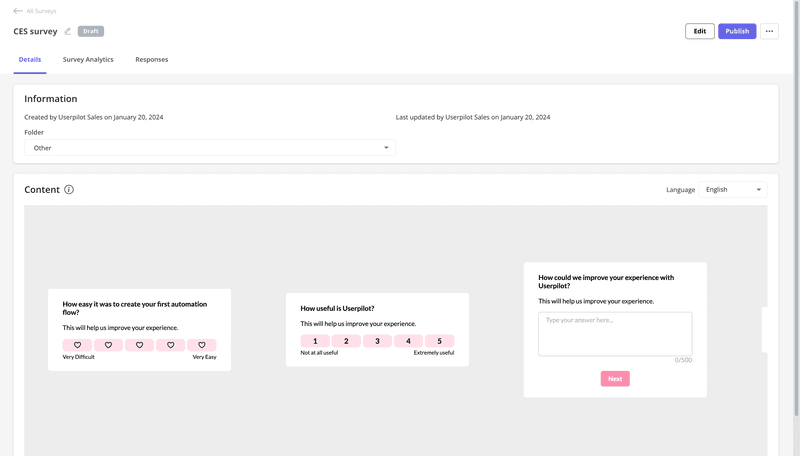
Translate the customer surveys to increase response rates
Talking about response rates: if your respondents don’t speak your language as a native tongue, they’re less likely to engage with the surveys.
And even if they do, the insights might not be valid because of limited understanding or ability to articulate their thoughts.
The solution?
Translate the surveys. With Userpilot, you can do it automatically, thanks to the AI-powered localization feature.
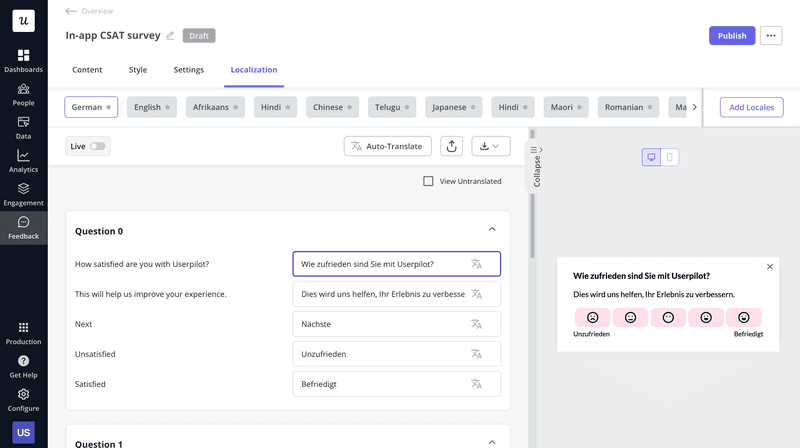
Trigger customer feedback surveys contextually
To get valid insights, you want users to respond to the survey when the experience is still fresh in their minds. Otherwise, they won’t remember. And might even not respond to the survey at all.
You can achieve this by using event-based triggering. This allows you to send surveys to users when they complete a specific action. For example, immediately when they use a feature, complete a task, or engage with your customer service representatives.
Event occurrence is one of the three triggering options in Userpilot.
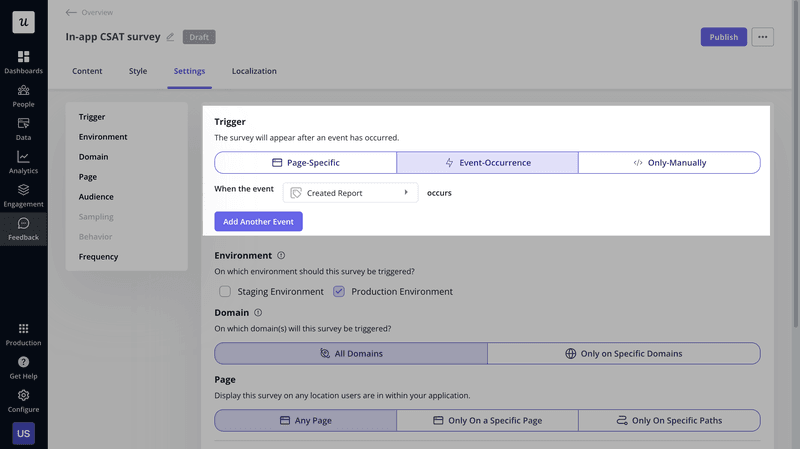
Use a multichannel approach to measure customer satisfaction
Such contextual in-app surveys are excellent because they allow you to reach the users when they’re engaging with the product, which increases the chance they will respond with valuable information.
But what if the user is inactive?
Use a different channel to send the survey, like email or SMS.
Userpilot offers a 2-way integration with HubSpot so you can target your inactive users with surveys via email. You can also trigger surveys via other channels with webhooks.
Schedule customer satisfaction surveys routinely
A one-off customer satisfaction survey gives you limited insights. It’s good to take the baseline, but it doesn’t tell you much about the changes in customer sentiment over time.
That’s why we recommend conducting customer satisfaction surveys regularly. Every 3-4 months is the norm for general surveys, but you can run them more often if you’re optimizing a particular aspect of user experience and want to keep the feedback loops tight.
However, running surveys too frequently can lead to survey fatigue and negatively affect response rates in the long run.
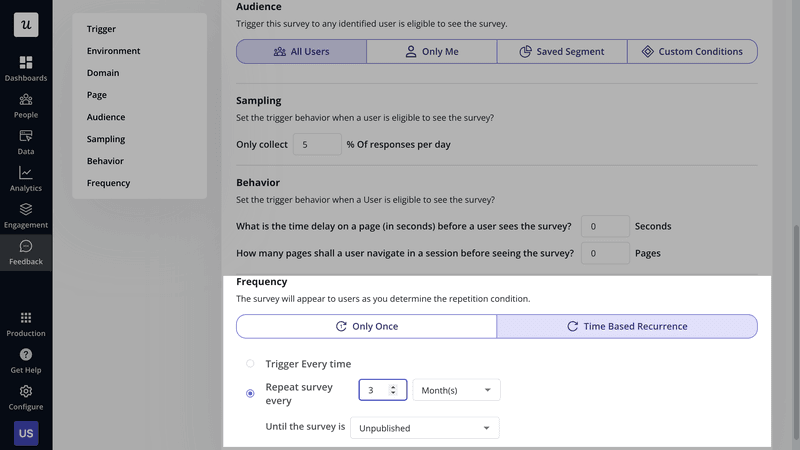
Add a progress bar to ensure survey completion
Progress bars don’t just make your surveys look more professional, but they enhance user experience and can increase your response rates.
How so?
They set realistic customer expectations as to the survey duration and give them a sense of how much is left. A user is unlikely to drop off if they see they have only 1 question left.
In fact, the progress bar can motivate them to finish it because it triggers a strong psychological mechanism called the Zegairnik effect.
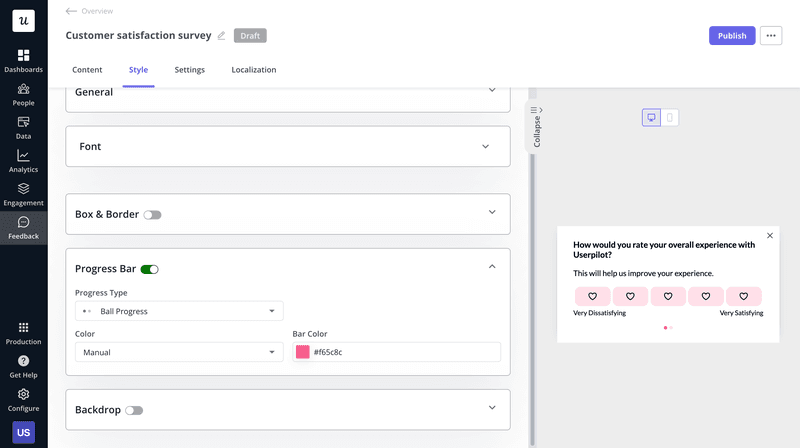
Monitor survey analytics and iterate your strategy accordingly
Survey analytics can help you monitor your survey performance and adjust it if necessary.
For example, if you discover that users tend to skip a particular question, you can reword it to make it easier to understand. Or remove it if it isn’t absolutely necessary for your research.
And if they drop off at a particular stage, shortening the survey may increase completion rates.
Userpilot offers detailed survey analytics that provides such insights. The scoreboard shows you:
- Total surveys shown.
- Total surveys completed.
- Completion rate.
- Average completion time.
You also get a graph that shows survey performance over time.
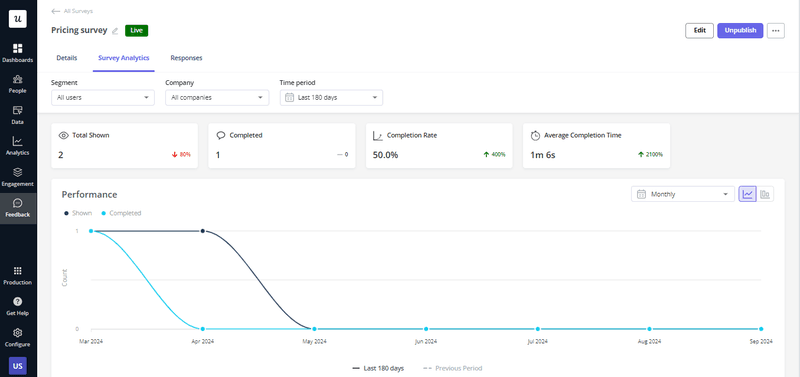
Examples of great customer satisfaction surveys from leading companies
To see how to implement these best practices, let’s have a look at a few customer satisfaction survey examples from well-known SaaS brands.
RecruitNow CSAT survey
RecruitNow is an Applicant Tracking System (ATS) that allows employment agencies and hiring managers to streamline the recruitment process.
The company uses CSAT surveys created in Userpilot to measure customer satisfaction and identify opportunities for improvement. These take place every six months.
As RecruitNow has expanded into the German and Austrian markets in recent years, Userpilot’s localization features are invaluable. It lets them quickly translate the surveys into different languages for higher user engagement.
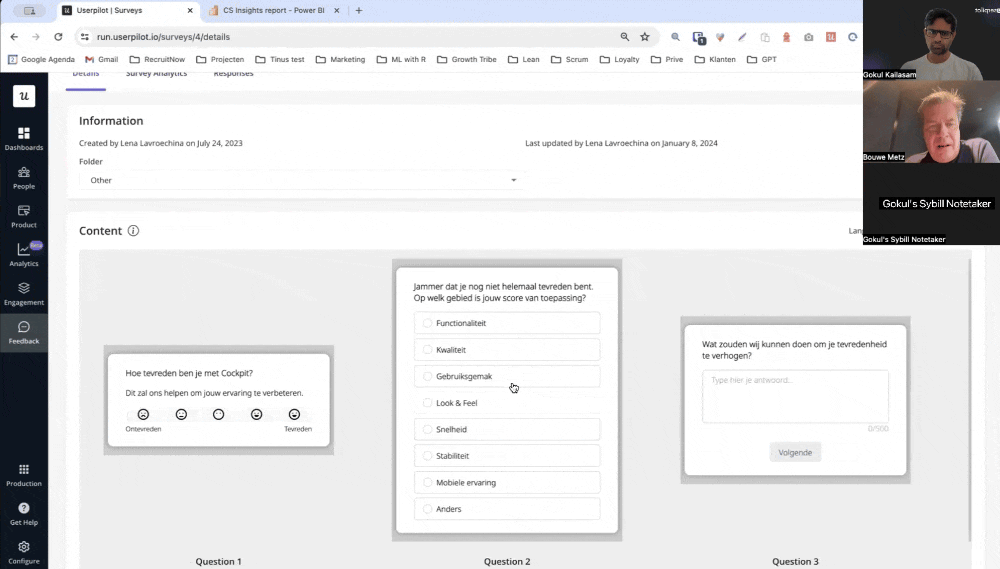
Wise email NPS survey
Wise, formerly known as TransferWise, is a leading international money transfer service. To collect valuable customer satisfaction data, the company employs email-based NPS surveys.
Why choose email?
Since many of Wise’s customers don’t use the service daily—often reserving it for tasks like monthly invoice payments—email is a more suitable medium for reaching them when it’s time to gather feedback.
See how concise and direct the email is?
A quick greeting, a brief introduction, and right into the standard Likert-scale NPS question. To make it even more intuitive, two emojis flank the scale and clearly indicate the negative and positive ends. This reduces any chance of confusion.
The design is simple, with just the company logo and minimal elements to keep the customer focused on the primary task – completing the survey.
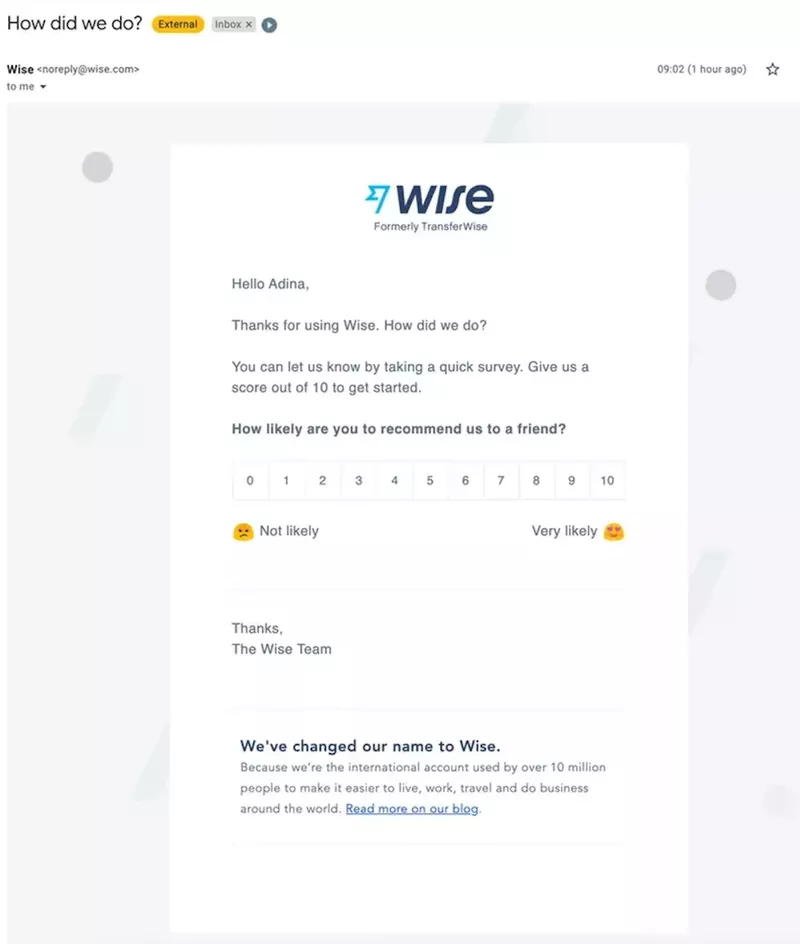
HubSpot onboarding satisfaction survey
HubSpot, a leading CRM and marketing automation platform, uses a simple in-app survey to gather feedback during the onboarding process.
When a user reaches the halfway point, Hubspot triggers this non-intrusive in-app survey to capture real-time insights on the onboarding experience.
Why this works:
- The survey is seamlessly integrated into the app experience. It appears when the user is already engaged with the platform.
- Its timing is strategic. HubSpot asks for feedback at a critical point in the onboarding process. Users have had enough experience to provide meaningful insights but are still early enough for adjustments to improve their journey.
- The in-app survey is simple and visually engaging. It uses three universally recognized smiley faces. This makes it quick and easy for users to provide feedback without any friction.
- It provides users with the option to give more detailed feedback after they answer the closed-ended question. This layered approach helps HubSpot capture both quantitative and qualitative data.
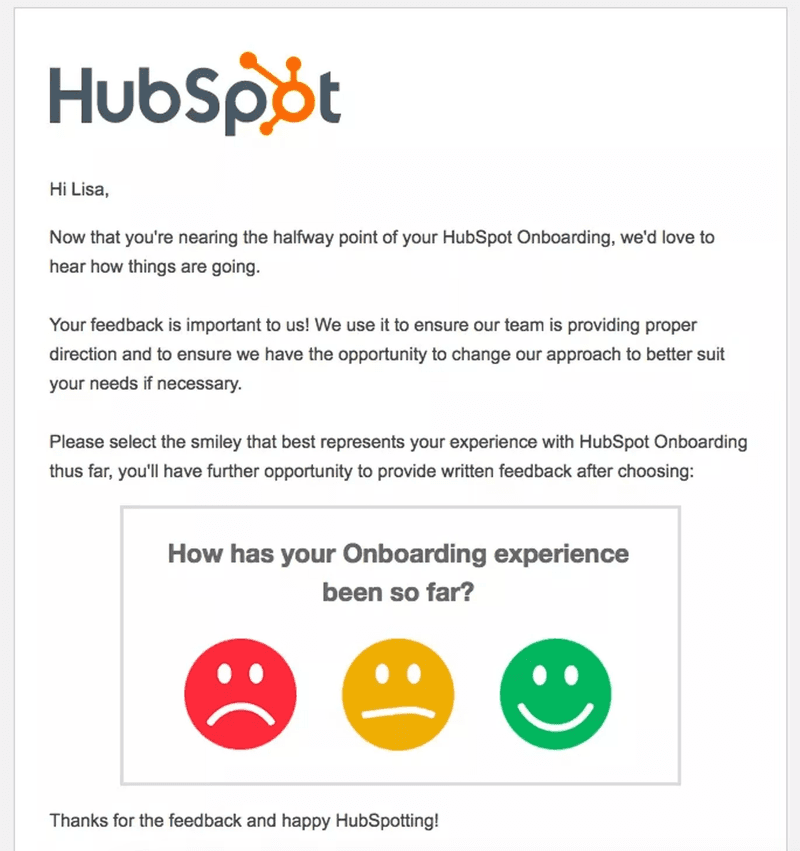
Jira CES survey
Jira, the well-known project management platform from Atlassian, uses CES surveys to collect real-time feedback on a specific task (editing a page in this case).
What makes the survey successful?
- Contextual triggering: It appears immediately after a user completes a specific task—publishing a page. This ensures more accurate and relevant feedback.
- Visual simplicity: The survey uses a row of expressive emojis to capture the user’s effort in completing the task. This reduces friction and makes the feedback process quick and intuitive.
- Follow-up open-ended question: There’s a text box for users to expand on their experience. This invites additional qualitative insights that can be used to identify areas for improvement. This is optional, however. Users who prefer quick responses can choose to only rate the experience and move on.
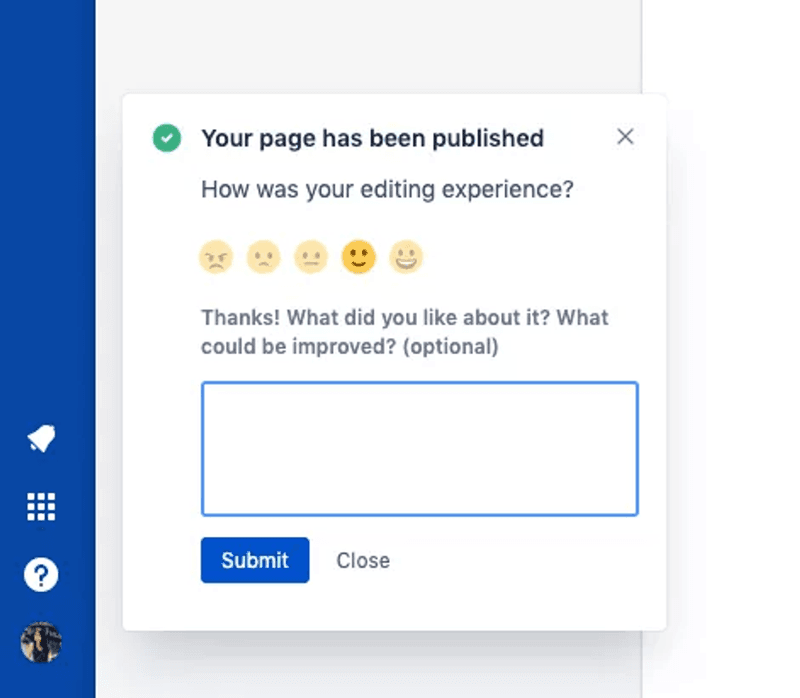
Userpilot customer feedback survey
Let’s wrap up with a customer satisfaction survey example you may have seen if you’re a Userpilot user.
The survey starts with a one-sentence greeting—”Thanks a lot for helping us make Userpilot even better”—and gets right to the question: “How was your experience with Userpilot?”
This is a rating question, and it uses smiley faces to help users quickly describe their satisfaction level.
The open-ended follow-up—”Do you have any specific feedback that you’d like to share with us?”— invites users to share their thoughts in more detail.
The slideout format of the survey makes it quick and easy for users to provide feedback without disrupting their workflow, which improves the chances they respond.
Having said that, the users can also quickly dismiss the survey if we catch them at the wrong time.
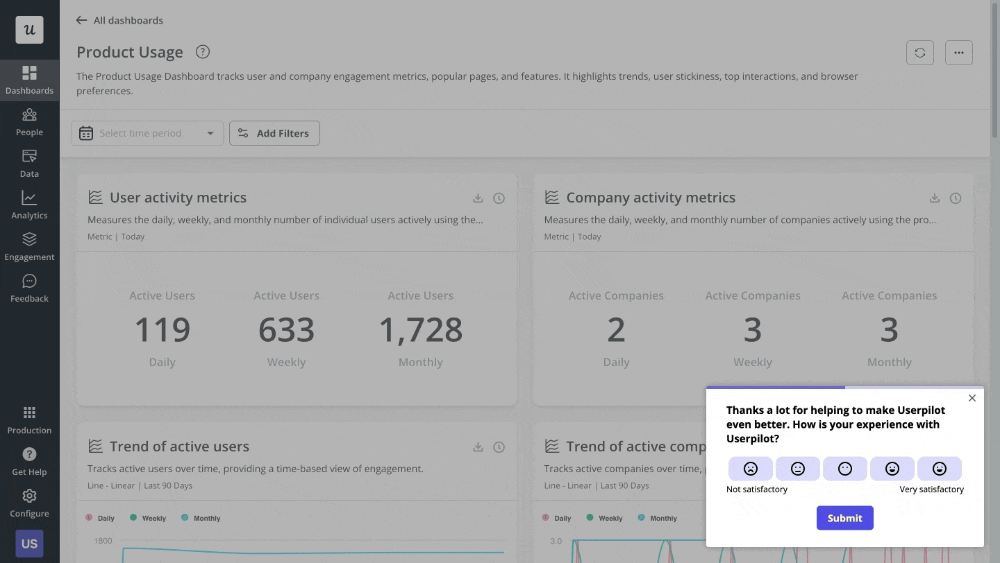
Frequently asked questions about customer satisfaction surveys
To finish, here are answers to some of the most frequently asked questions about customer satisfaction surveys.
What is the importance of using customer satisfaction surveys?
Customer satisfaction surveys are crucial for understanding your customer needs and preferences. By collecting satisfaction feedback, you can:
- Gauge user sentiment towards your product.
- Track your product performance over time and measure the impact of product changes.
- Identify ways to add value to the product.
- Spot signals of customer discontent and pinpoint its causes before they escalate.
Customer satisfaction is closely linked with their retention. Satisfied customers are also more likely to upgrade to higher plans and recommend your product via word of mouth, driving your customer acquisition and account expansion.
How to measure customer satisfaction?
Measuring customer satisfaction involves using various tools and metrics.
Common methods include customer satisfaction score (CSAT), Net Promoter Score (NPS), and Customer Effort Score (CES) surveys.
These surveys ask customers to rate their experience on a scale and provide insights into what’s working well and what needs improvement.
What is the best customer satisfaction survey?
The best customer satisfaction survey is one that is well-designed, relevant, and tailored to your business objectives.
For example, if you aim to improve customer loyalty, an NPS survey is more suitable. To enhance product usability, you will use a CES survey.
Best customer satisfaction surveys are also concise, easy to understand, and avoid double-barrelled questions. Like ‘How would you rate your experience with the product and why did you like it?”
Breaking it down into ‘How would you rate your experience with the product? and “What made you like this about the experience?” will give you more helpful insights.
Conclusion
A customer satisfaction survey is an essential tool in your toolkit, whether you’re a product, customer success, or customer support manager. It allows you to understand how your users feel about your product experience and nip potential issues in the bud before they lead to churn.
If you’d like to learn more about Userpilot feedback functionality and how it can help you collect customer satisfaction feedback effectively and efficiently, book the demo!







